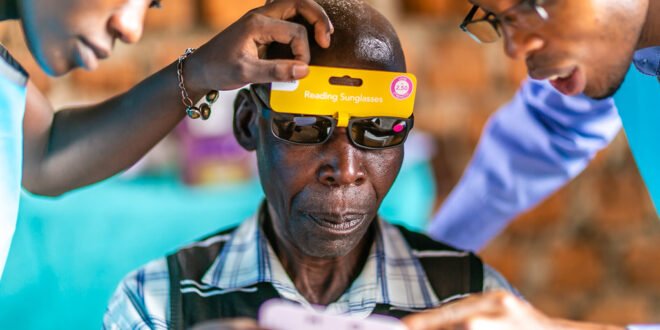Addressing a Critical Health Challenge in Uganda
Uganda is facing a significant burden of visual impairment, with more than six million people affected and 400,000 individuals completely blind. This issue has been highlighted by the Ministry of Health, which has taken decisive steps to address the growing need for eye care services across the country.
The Ministry of Health recently launched a six-month distribution campaign aimed at providing 41,200 reading glasses and conducting vision screenings in high-impact districts, particularly in Eastern Uganda. This initiative seeks to bridge a critical gap in eye care that has left millions of Ugandans with untreated visual impairments. The program was supported by several partner organizations, including Evidence for Action and the Clinton Health Access Initiative (CHAI), which contributed 25,000 and 16,200 reading glasses respectively.
Dr. Charles Olaro, Director General of Health Services, emphasized during the rollout on July 30 that the lack of affordable assistive devices has deepened poverty, especially among women and the elderly. He noted that visual impairment has socio-economic effects, limiting people’s ability to support themselves or be productive. “After the age of 40, many lose part of their sight—especially the lens as it ages—yet few can access affordable reading glasses. This leaves them unable to work, count money, farm, or perform basic tasks like cooking safely,” he said.
The Ministry has prioritized Busoga and Bukedi regions, where the levels of visual impairment are highest. Dr. Olaro mentioned that the cost of each pair of glasses is just USD 1, making them an affordable solution for those in need. Distribution will follow regular health channels, ensuring that the glasses reach those who need them most.
He also warned health teams to ensure that the glasses go to people with genuine visual impairments. This initiative is part of a long-term plan to integrate assistive devices into Uganda’s essential health-care package, which includes health promotion, prevention, curative services, rehabilitation, and palliative care.
Richard Kibuuka, Country Director of Evidence for Action, explained that the program is designed to meet immediate needs while testing scalable delivery models for cost-effective eye-care solutions in rural communities. “We have evidence that one in six people over 40 suffers from presbyopia, which affects quality of life and productivity. This pilot will help us test and scale models for earlier screening and affordable distribution,” he said.
Joy Batuusa, Country Director for CHAI Uganda, noted that the initiative aligns with Uganda’s new national strategy for assistive technologies. She highlighted that donations are coordinated and policy-driven. “We’ve worked with the Ministry of Health on malaria, reproductive health, and vaccines, but we also saw the unmet need among people with disabilities. We are starting with eye health because it is the most prevalent challenge. Today, we have donated 6,500 glasses, and we will continue to mobilise resources,” she said.
Batuusa added that the ultimate goal is to make access to reading glasses and other assistive products a permanent part of community health services. Plans include extending support to children in schools who are often left behind due to vision challenges.
Schedule 3 of the Persons with Disabilities Act (Chapter 115) defines disability categories to include physical, hearing, and visual disabilities, as well as mental, developmental, and multiple disabilities. According to the 2024 Uganda Bureau of Statistics Census Report, persons with disabilities constitute 13.2 percent of Uganda’s population.
This initiative represents a crucial step forward in addressing the challenges faced by visually impaired individuals in Uganda. By focusing on early detection, affordable solutions, and sustainable integration into the healthcare system, the government and its partners are working towards a future where everyone has access to the tools they need to lead productive and fulfilling lives.
 Info Malang Raya Its All About World News
Info Malang Raya Its All About World News




